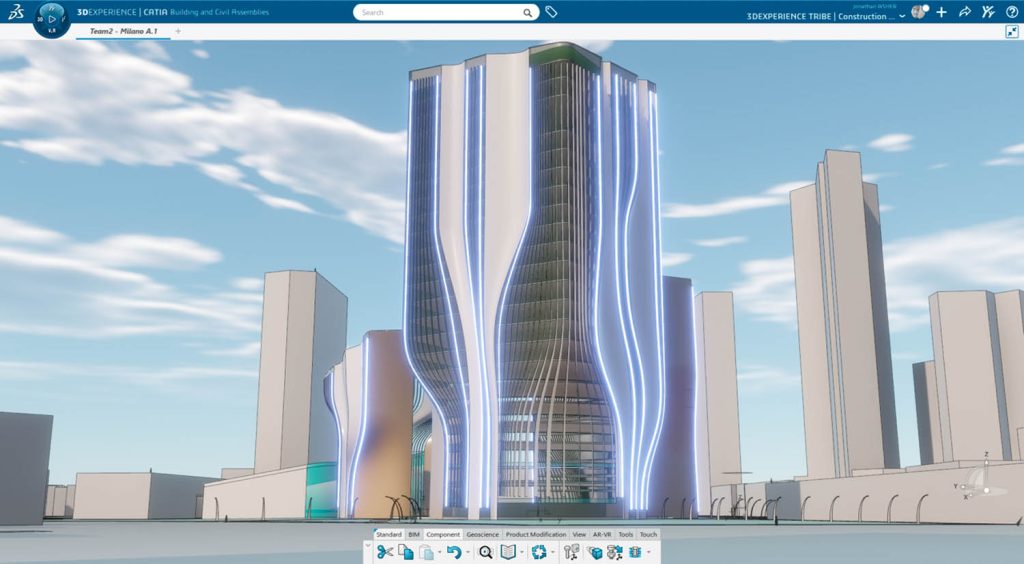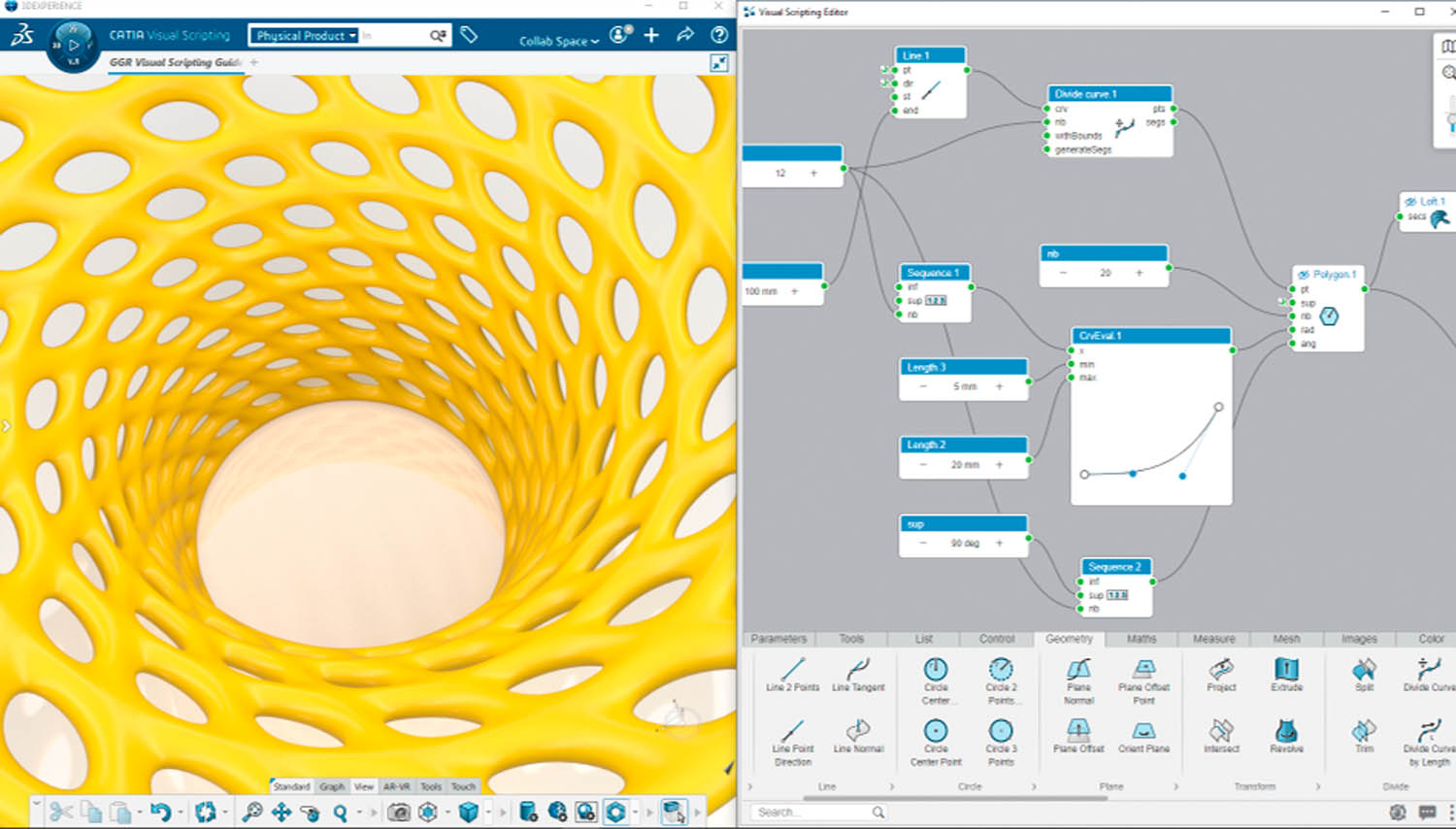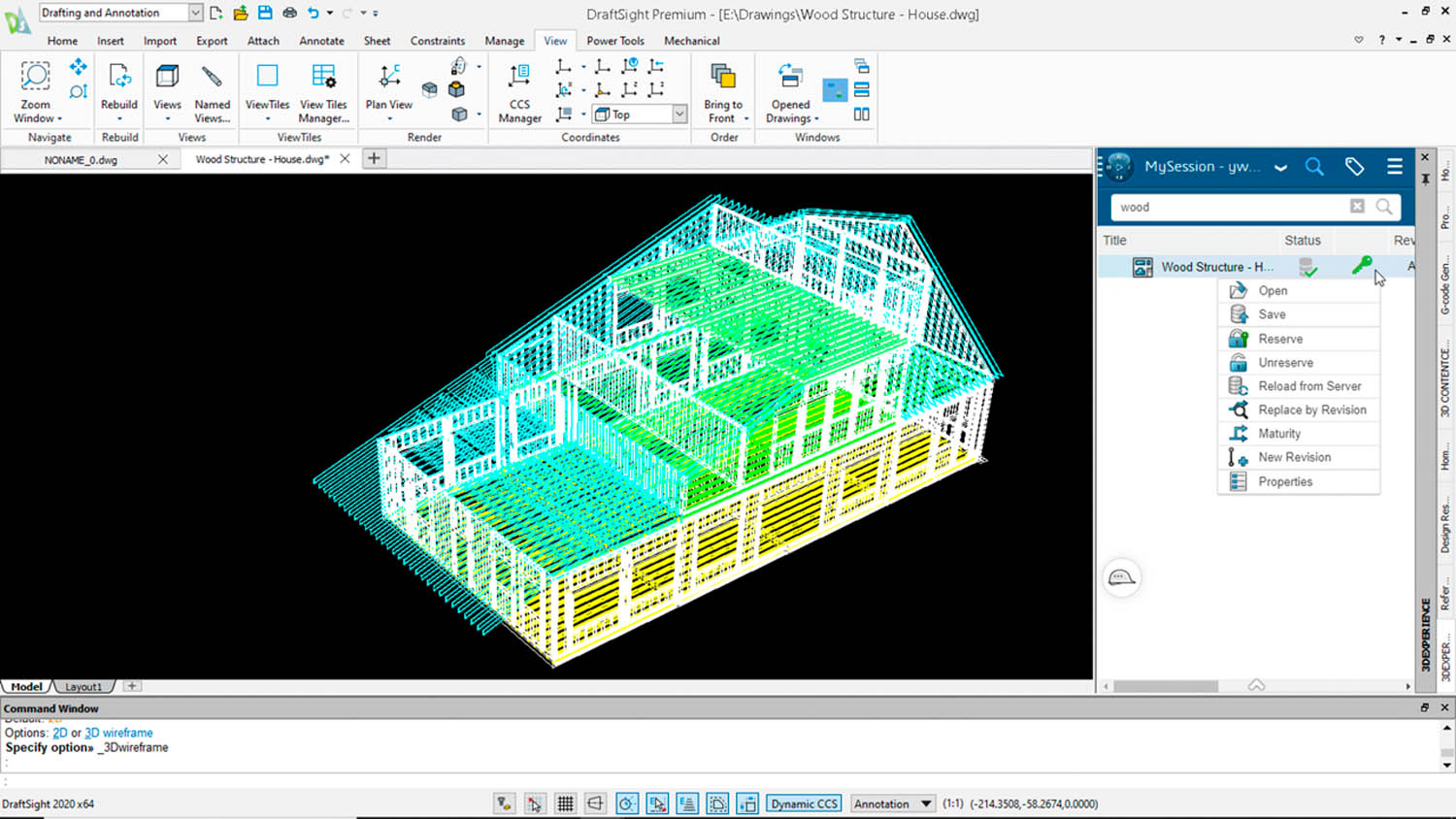In recognition of the fact that AEC customers require different pricing structures from those in the automotive and aerospace sectors, Dassault Systèmes (DS) recently introduced a Catia for AEC bundle deal
Catia sits at the Ferrari end of the manufacturing CAD spectrum. It’s typically used in demanding engineering design projects in the automotive, aerospace and maritime sectors. Here, the CAD package built and sold by Dassault Systèmes demonstrates its strength in handling complex geometries and huge assemblies, with advanced simulation and analysis thrown into the mix.
All this means that applying Catia to AEC projects might initially seem like overkill. However, as BIM has evolved, AEC users are increasingly creating large, complex datasets that they hope to carry into digital fabrication. In addition, DS has championed the digital twin concept from its earliest days.
The upshot is that this is not so much a case of Catia moving into AEC, but AEC customers increasingly needing the kinds of capabilities that Catia provides. To date, DS has notched up numerous successful wins in AEC: with construction companies such as Bouygues and advanced architecture practices including ZHA and SHoP, for example, as well as façade design firm Felix and a number of global modular construction firms. The software has also been used on a number of significant Chinese infrastructure projects.
Find this article plus many more in the May / June 2025 Edition of AEC Magazine
👉 Subscribe FREE here 👈
Get bundling
This year, DS has been ramping up its efforts to position Catia as a competitive AEC design platform option. In particular, it has focused on addressing the platform price issue, by bundling up several apps and capabilities to encourage team adoption in the sector. The core Catia for AEC bundle comes with capabilities for advanced modelling, BIM design, generative design/scripting and 2D drawings.
So what’s included in this bundle? At its heart is the full, unadulterated Catia experience.
While the company offers a version that runs in the cloud (namely, 3DExperience Platform), there is also a desktop flavour that DS executives refer to as the product’s ‘rich client’.
The Catia for AEC bundle is based on this desktop variant for performance reasons, although all data is stored in the cloud and is therefore accessible via a web interface. The platform supports simultaneous work on the same dataset and provides access to collaborative web applications that use the same live data.
The role of the user is defined as the building design engineer, who needs access to parametric modelling, automation and advanced surface modelling (Class A, subdivision and parametric), as well as live rendering with materials libraries for buildings, and specific building-specific tools.
These building-specific applications cover concept structure design; detailed structures for steel and concrete connections; BIM for elements like walls and doors; geolocation capabilities; terrain and mesh modelling; and cut-and-fill operations.
It’s important to note that this building design engineer role does not, however, include mechanical, electrical, or plumbing (MEP) functionalities.
While I don’t expect many firms in the AEC sector to abandon their current BIM tech stacks wholesale and adopt one based on Catia instead, I can certainly see the Catia bundle being added to the mix to tackle specific complex projects and hard-to-solve geometric problems
Collaboration is a key element of the core platform provided by the underlying 3DExperience Platform. The cloud capabilities facilitate simultaneous work on the same dataset. Models are partitioned into individual components or parts, and users can ‘reserve’ or ‘lock’ parts that they are working on, in order to prevent others from overriding their geometry.
When a user saves their changes to the database, others working within the same assembly can synchronise their sessions to see the updates, although the software doesn’t support real-time visualisation of movement.
The Visual Script Designer, meanwhile, is a powerful Catia-specific generative design tool with a visual scripting-style interface. This enables designers to craft scripts through building blocks, so that they can generate 3D geometries autonomously. DS executives claim the Visual Script Designer is easy to use, even by those without programming skills.
For drafting, there’s DraftSight Premium, a standalone, full version of DS’s 2D DWG-based drafting application. While this is a desktop application, it is also connected to the 3DExperience Platform, so that users can save DWG and DXF data to the cloud.
It also includes a BIM module that enables the import of IFC and Revit models in order to produce 2D drawings. The workflow between Catia and DraftSight currently involves exporting IFC data from Catia, saving it to the cloud, and then importing it into DraftSight. Over time, we expect this integration to improve and expand to include important productivity boosts, such as auto drawing capabilities.
While Catia includes several drafting applications, DraftSight is noted as a better 2D drawing environment, particularly for architectural and structural drawings, than other offerings that are better suited to mechanical CAD and/or civil drawings. The Catia for AEC Special Offer is available in several different configurations. They include:
Single user: $6,500 per year or $1,950 per quarter for an individual subscription.
Three user: $16,800 per year or $5,000 per quarter. This bundle equates to a price of $5,600 per user, per year or $1,680 per user, per quarter. Buying the 3-user bundle saves 14% off the single user price.
Six user: $27,000 per year or $8,100 per quarter. This bundle offers the lowest per-user price, as it works out to $4,500 per user, per year, or $1,350 per user, per quarter. This bundle represents a saving of 30% off the single user price.
Learning curve
At present, Catia is still not widely used in the AEC space – so there remains an issue with attracting and training architects to use the software. On YouTube, there’s an eleven-episode video series that walks them through the Catia building design fundamentals (www.youtube. com/@CATIAAEC), as well as an associated wiki that provides datasets and documentation.
The Catia for AEC bundle offers the kinds of capabilities that many expert modellers lust after, as well as helping firms to speak the same language as their business partners in fabrication
There are also plans to revamp the wiki for easier navigation and to add a new ‘Getting Started’ section. Assistance is also available from a public Buildings and Infrastructure community on 3DSwym, a collaborative communication environment where questions can be posted and answered.
There are also online tutorials available for DS’s Visual Scripting tool that amply demonstrate its powerful capabilities. It looks to work in a very similar way to Grasshopper or Rhino, with graph nodes and connectors.
DS’ Visual Scripting also has online tutorials, which will, with just a brief poke around, clearly demonstrate the powerful capabilities of this scripting module. The visual scripting looks to work in a very similar way to Grasshopper/Rhino with graph nodes and connectors. The CGM kernel and scripting make for a very powerful geometric combination.
In conclusion
The Catia for AEC bundle is offered at an aggressively low price, in DS terms. The cost would be low for Catia alone, but here, you’re also getting the Scripting and DraftSight modules.
In terms of function, it may not compare to Autodesk’s AEC Collection, which is stuffed with product. However, only four of them are regularly used by many users: AutoCAD, Revit, Navisworks and 3ds Max. For most users, the DS bundle will cover most requirements.
While I don’t expect many firms in the AEC sector to abandon their current BIM tech stacks wholesale and adopt one based on Catia instead, I can certainly see the Catia bundle being added to the mix to tackle specific complex projects and hard-to-solve geometric problems. It offers the kinds of capabilities that many expert modellers lust after, as well as helping firms to speak the same language as their business partners in fabrication.
The inclusion of DraftSight is significant. We already know that this tool will soon be getting auto drawing capabilities.
In short, this is a bundle of tools that will only get better over time.
From the perspective of prospective AEC customers, DS needs to concentrate on delivering more training tools for the bundle. It should look to integrate it with some of the tools more commonly used in AEC, as well as point clouds, Rhino, CDEs, alternative renderers and perhaps some of the newer, open source offerings.
And there’s certainly a desire among them to put Catia to work on AEC Projects. For example, in the early 2000s, Hugh Whitehead from the Specialist Modelling Group at Foster + Partners told us that Catia would be his tool of choice (at that time, Foster + Partners was using Bentley Systems MicroStation, powered by Parasolid).
Whitehead described a project that featured a very complex guttering design. As it was being modelled, this design repeatedly crashed the firm’s tools. Eventually, Whitehead ended up in Italy, watching the fabricator successfully model this ‘impossible’ part in Catia, albeit after several attempts, and resolve the geometry issue.
Said Whitehead: “Other modellers just crash out when they fail. You have no idea why the problem happened. Catia may fail, but it won’t crash – and it will even tell you why it could not produce the geometry asked for.”
For many in AEC, that could be an appealing prospect.
Dassault Systèmes will be at NXT BLD and NXT DEV on 11-12 June.
Catia for AEC: Who’s the target user?
In the AEC industry, even the best and the brightest designers and engineers are working with tools that are incomplete and inefficient. That’s the argument put forward by Jonathan Asher, Catia global sales director when he recently met with AEC Magazine to discuss the launch of Catia for AEC.
These professionals, he continued, are tasked with forcing point solutions to work together, leading to a big waste of productivity. Designers struggle to patch holes and spend time searching for workarounds that will compensate for insufficient modelling capabilities. BIM tools, he added, “were created to deliver scaled drawing sets, not detailed 3D models for fabrication.”
Another key problem, according to Asher, is that with today’s “midrange desktop modellers” like Revit, users soon hit a “scalability wall”, because file size is a major issue in BIM that frequently impacts collaboration and performance.
Asher contrasted these failings with what’s on offer from Catia, which he claimed scales with the size and detail of a project, and is database-based (rather than file-based) on the 3DExperience Platform, which benefits collaboration and performance.
DS has been eyeing the AEC market since 2012, so it has taken the firm quite a while to pull its software together to compete in the market. The fact that the digitisation of the AEC industry is now focusing on the manufacturing of buildings opens up a convergence opportunity for DS, as Catia is already relevant there.
When asked who the target user of the Catia for AEC bundle might be, Asher replied: “It’s someone who is kind of stuck between Rhino, Grasshopper and Revit. This ‘super user’ is working on multiple projects, at different phases, and is stretched between multiple applications, trying to connect disparate tools.”
He argued that the bundle is highly price-competitive for users already using both Autodesk’s AEC Collection and Rhino, especially when factoring in the costs of Autodesk’s cloud collaboration and potential clash detection/viewing tools that Catia also provides.
Asher recognised that there are still significant barriers to adoption of Catia in AEC. This includes the investment users have already made in existing tools like Rhino, where people have built their careers around using Rhino, teaching Rhino and developing a Revit ecosystem. He also implicitly acknowledged the learning curve associated with a CAD system such as Catia.
Understanding Catia
Catia is a platform. Its core modeller is based on DS’s own CGM (Catia Geometric Modeller) kernel for solids, surfaces and meshes. On top of that modeller, there are thousands of plugins that enable the platform to offer a wide range of capabilities.
Typically, these are purchased around industry design bundles, including Design and Styling, Digital Prototyping, and Sustainability. They are also based on roles. These bundles include selections of tools, from carbon fibre design to advanced generative design – in short, whatever capabilities make sense for those roles.
It’s easy to switch between these specific applications within the main Catia environment using its ‘compass’ interface, which provides new user interfaces, commands and functionality.
There are several different licensing options, including quarterly and yearly subscriptions, as well as perpetual licences that include an annual maintenance fee.
A significant capability of Catia is its ability to handle very large models – even complete virtual twins with every nut and bolt featured, such as those created in the automotive and aerospace industries.
Catia manages this through its assembly logic. When assembling many components, it primarily loads only the visual representation of the data, not the full authoring data. The detailed internal data and parametrics are only loaded into memory when a specific part is activated.
This enables users to model ‘in context’, while only loading the data they need, with other parts displayed as visualisation geometry. The first time a model is opened locally, it takes time to grab the visualisation data, but subsequent openings are faster as it performs a difference check with the cloud data.













